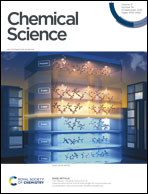Soft crystal lattice and large anharmonicity facilitate the self-trapped excitonic emission in ultrathin 2D nanoplates of RbPb2Br5†
Abstract
Self-trapping of excitons (STE) and concomitant useful broadband emission in low-dimensional metal halides occur due to strong electron–phonon coupling, which exhibit potential applications in optoelectronics and solid-state lighting. Lattice softness and high anharmonicity in the low-dimensional structure can lead to transient structural distortion upon photoexcitation that should promote the spatial localization or trapping of charge carriers, which is essential for STE. Herein, we report the ligand-assisted reprecipitation synthesis of ultrathin (∼3.5 nm) two-dimensional (2D) metal halide, RbPb2Br5 nanoplates (NPLs), which demonstrate highly Stokes shifted and broadband emission covering most parts of the visible to near IR range (500–850 nm) with a long-lived photoluminescence (PL) lifetime. The excitation wavelength independent emission and emission wavelength independent excitation spectra along with the analogous PL decay kinetics of bulk and NPLs suggest the intrinsic nature of broadband emission. The experimental low sound velocity (∼1090 m s−1) and associated low bulk and shear moduli (10.10 and 5.51 GPa, respectively) indicate the large anharmonicity and significantly soft lattice structure, which trigger the broadband STE emission in 2D NPLs of RbPb2Br5. Strong electron-longitudinal optical (LO) phonon coupling results in broadband STE emission in 2D RbPb2Br5 NPLs.



 Please wait while we load your content...
Please wait while we load your content...